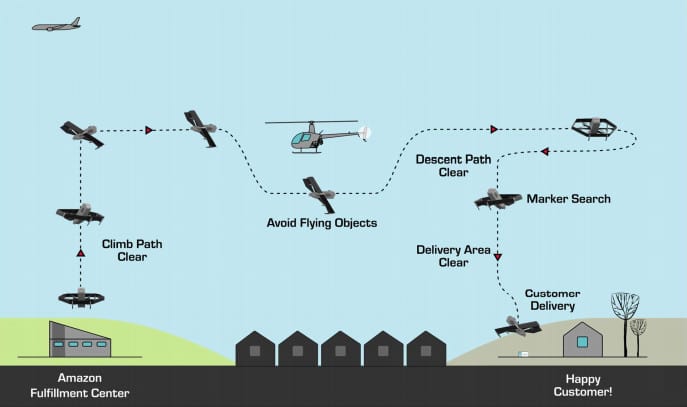After the June unveiling of its “hybrid” design drone in Las Vegas, Amazon is now asking for relief from federal regulations for commercial deliveries.
According to a petition published on August 8 by the Federal Aviation Administration (FAA), Amazon Prime Air, the company’s drone operating subsidiary, is requesting an exemption to conduct operations under what is known as a “Part 135” air carrier operating certificate for its MK27 unmanned aircraft system (UAS).
As the company stated in June, Prime Air plans to deliver packages of up to 5 pounds to customers within 30 minutes of placing an order. The MK27 can deliver within a range of 15 nautical miles (approximately 17 statute miles) to a variety of customer locations and designated drop-off points, which represents 80 to 85 percent of the products that Amazon Prime sells, according it application letter submitted by Sean Cassidy, Director of Safety and Regulatory for Amazon Prime Air.
“This year we demonstrated our commitment to our customers by announcing our expansion of one-day delivery with Amazon Prime,” Cassidy said. “We anticipate Prime Air will be the same type of game-changing service for our customers.”
Drone applications from big-player companies vying for customers demanding faster delivery are starting to accumulate at the FAA. Wing Aviation, a subsidiary of Google parent Alphabet Inc. [NASDAQ: GOOGL], was the first to receive approval from the agency for commercial drone operations, with initial plans in the Blacksburg-Roanoke area in southern Virginia.
“UPS Flight Forward,” the drone unit of UPS [NYSE: UPS], announced it had recently applied for a Part 135 exemption as well.
Prime Air claims that its UAS “will achieve a level of safety equivalent to the level that complies with the requirements described below would otherwise achieve,” according to its application, and therefore granting the exemption is in the public interest.

As with other commercial drone operators, Prime Air will fly below 400 feet, with exceptions made to avoid uncharted objects. “Operations will begin over areas with low population density that have been thoroughly vetted for proximate airborne operations, obstructions, communications coverage, and sensitive overflight areas, and will be subject to FAA approval in the form of a certificate of authorization,” according to the company. “We will seek to expand our areas of operation based on the submission of the appropriate operational plan and risk mitigations necessary” for further certificates, it stated.
When its drone arrives close to the delivery location, it will transition from horizontal to vertical flight, identify the specific delivery area through a unique marker, descend to a safe delivery height, hold in a hover, and if doesn’t sense obstructions or hazards, will release the package. “Even though our system is designed with default fail-safe logic to abort the delivery if an obstruction is detected, the [drone operator] will have the ability to discontinue the delivery phase for any reason.”
The application did not provide a timeline for startup and initial location of commercial deliveries in the U.S., noting only that the company is committed to “working in lock-step with regulators, and will only proceed and scale when, together, we are fully satisfied that it is safe to do so.”







